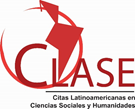Uso de la videoconferencia en el aprendizaje colaborativo de los estudiantes de una universidad peruana
Resumen
Este estudio tuvo como objetivo caracterizar el uso de la videoconferencia en el aprendizaje colaborativo de los estudiantes de una universidad peruana. Se desarrolló bajo el enfoque cuantitativo, con diseño no experimental, de tipo básica y nivel descriptivo. La población fue de 328 estudiantes del noveno y décimo ciclo de la Facultad de Humanidades, la muestra fue de 125 estudiantes elegidos por medio de un muestreo no probabilístico intencional o por conveniencia. La técnica para recoger los datos fue la encuesta y el instrumento el cuestionario, los cuales fueron validados por juicio de expertos, la fiabilidad se examinó con el coeficiente Alfa de Cronbach a través de una prueba piloto a una muestra con características similares. Los resultados revelan que la caracterización del uso de la videoconferencia en el aprendizaje colaborativo de los estudiantes de una universidad peruana permite precisar que la mayoría de los encuestados con 56% reportan un nivel moderado, seguido del 32% con un nivel alto y un 12% con un nivel bajo. Por lo que se considera que los docentes han tenido que recurrir a las novedosas tecnologías para llevar a cabo el proceso de enseñanza-aprendizaje.
Palabras clave:
Videoconferencia, aprendizaje colaborativo, interdependencia positiva, relación psicosocial, habilidades de colaboración
ABSTRACT
This study aimed to characterize the use of videoconferencing in collaborative learning by students at a Peruvian university. It was developed under the quantitative approach, with a non-experimental design, basic type and descriptive level. The population was 328 students of the ninth and tenth cycle of the Faculty of Humanities, the sample was 125 students chosen by means of intentional or convenience non-probabilistic sampling. The technique to collect the data was the survey and the instrument the questionnaire, which were validated by expert judgment, the reliability was examined with the Cronbach's Alpha coefficient through a pilot test on a sample with similar characteristics. The results reveal that the characterization of the use of videoconference in the collaborative learning of the students of a Peruvian university allows specifying that the majority of the respondents with 56% report a moderate level, followed by 32% with a high level and 12% with a low level. Therefore, it is considered that teachers have had to resort to new technologies to carry out the teaching-learning process.
Keywords:
Videoconference, collaborative learning, positive interdependence, psychosocial relationship, collaboration skills
Descargas
Publicado
Cómo citar
Número
Sección
Licencia
Derechos de autor 2023 Editorial Universo Sur

Esta obra está bajo una licencia internacional Creative Commons Atribución-NoComercial-SinDerivadas 4.0.
La editorial "Universo Sur", de la Universidad de Cienfuegos, publica el contenido de la Revista "Conrado" bajo una Licencia Creative Commons Atribución-NoComercial-SinDerivar 4.0 Internacional.
© Podrá reproducirse y socializarse, de forma parcial o total, el contenido de esta publicación, sin fines comerciales, siempre que se haga de forma literal y se mencione la fuente.







